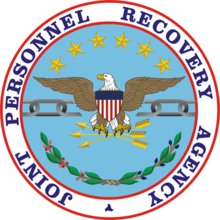Joint Personnel Recovery Agency
| Joint Personnel Recovery Agency | |
|---|---|
 Official Seal of JPRA | |
| Active | October 1, 1999 |
| Country | United States |
| Type | Chairman's Controlled Activity |
| Headquarters | Fort Belvoir, Virginia |
| Motto(s) | "These things we do that others may live... to return with honor." |
| Website | www.jpra.mil |
The Joint Personnel Recovery Agency (JPRA) is a Chairman's Controlled Activity and is designated as DoD's office of primary responsibility for DoD-wide personnel recovery (PR) matters, less policy. JPRA is headquartered in Fort Belvoir, Virginia with schools located in Fredericksburg, VA and Spokane, WA.[1] JPRA currently provides for commanders, forces, and individuals on joint PR activities through development and conduct of education and training courses, and specialized individual training. The agency assesses, advises, and evaluates PR curriculum and establishes Joint PR standards in collaboration with the DoD Components for formal Joint PR training, including Code of Conduct and SERE. JPRA also provides DoD Components with analytical support, technology research and integration, maintenance of databases and archives, and development of lessons learned. JPRA encourages partnerships by assisting with non-DoD agencies, multinational partners, and others, with PR-related education and training programs.[2]
Vision Statement
Deny our adversaries the ability to hold isolated personnel against their will.
Mission Statement
Teach-Support-Integrate
To enable commanders, forces, and individuals to prevent, prepare for, and respond to isolating events.
Core Competencies
- EDUCATION & TRAINING – Prepare commanders, staff, forces, and individuals to conduct joint PR activities, provide specialized individual PR/SERE training, and maintain the capability to assist other USG departments/agencies, partner nations, or others when directed.
- OPERATIONAL SUPPORT – Provide planning support, risk assessment, and mission analysis to support commanders globally with representation at the combatant commands; development of PR operational and intelligence support products; DoD program management of non-conventional assisted recovery, blood-chits, and SERE psychology, and assist with reintegration of returnees and support to their families.
Enabling Functions
- OVERSIGHT & GUIDANCE – Assess joint/combined exercises and SERE training curriculum and standards while incorporating lessons learned into doctrine, TTPs, and guidance that improve interoperability with interagency and multinational partners.
- ANALYSIS & ADAPTATION – Provide direct analytical support to warfighters through modeling and simulation and new concepts for the preparation, planning, execution and adaptation of personnel recovery.
- TECHNOLOGY INTEGRATION – Research, develop, facilitate, assess, and oversee joint PR technologies, experiments and TTPs.
The goals of the Joint Personnel Recovery Agency include: Returning isolated US personnel to friendly control, denying enemies of the US a potential source of intelligence, preventing the exploitation of captured US personnel in propaganda programs, and maintaining the morale of US fighting forces and the "national will." According to the US Department of Defense (DoD), the agency's "core" capabilities consist of providing personnel recovery guidance, developing, conducting, and supporting personnel recovery education and training, providing support to operations, exercises, and deploying forces, and ensuring that personnel recovery remains viable through the adaptation of lessons learned, research and development, and other validated inputs.[3]
Agency Seal
The blue background, symbolizing sky and space, exemplifies the limitless boundaries of DOD recovery operations worldwide.
The red, white and blue border connotes the personal sacrifices of past warriors who have suffered physical and mental anguish in their loss of freedom, and even life, in defense of the country's ideals and the valor with which all services carry out their personnel recovery missions.
The stars denote the six articles of the Code of Conduct which stand as guiding lights to help U.S. warriors navigate the dangerous territories of Survival, Evasion, Resistance and Escape (SERE) toward ultimate recovery.
The eagle and wreath are adapted from the seal of the Department of Defense and symbolize the commitment of Department of Defense forces to protect isolated personnel and the swiftness of response.
The laurel (left side of the wreath) represents honors received in combat and the olive branch (right side of the wreath) represents defending peace.
The broken chain depicts the mental and physical oppressions that the Code of Conduct, personnel recovery training and DOD Recovery Forces serve to defeat.
History
The JPRA has its roots in World War II and the Korean War. In 1942 a military intelligence service was formed to aid US forces to evade and escape from the enemy. In 1952 the United States Department of Defense (DoD) designated the United States Air Force as executive agent (EA) for escape and evasion activities. Training was mostly for pilots and aircrew as they were considered the most likely to be isolated. After the Korean War, DoD implemented a Code of Conduct for the Services; it was revised after the Vietnam War.
In the early 1990s, DOD began to focus more on the importance of personnel recovery (PR) and in 1991 the Joint Services Survival, Evasion, Resistance, and Escape (SERE) Agency (JSSA) was designated the DoD EA for DoD Prisoner-of-War/Missing-in-Action matters. In 1994 the Joint Staff appointed the JSSA as the focal point for PR. The Department appointed the US Air Force as the Executive Agent for Joint Combat Search and Rescue (JCSAR). In 1999 JPRA was created as an agency under the Commander in Chief, US Joint Forces Command (USJFCOM) and was named the Office of Primary Responsibility (OPR) for DoD-wide PR matters. After the disestablishment of USJFCOM, JPRA was designated a Chairman’s Controlled Activity in August 2011.
References
- ↑ JPRA Public Homepage. "About the Joint Personnel Recovery Agency" (Agency Identity). United States Department of Defense. Retrieved July 22, 2014.
- ↑ JPRA Public Homepage. "About the Joint Personnel Recovery Agency" (Agency Identity). United States Department of Defense. Retrieved July 22, 2014.
- ↑ Rhem, Kathleen (May 10, 2006). "Personnel Recovery Agency Works to Bring All Americans Home Alive" (Press release). United States Department of Defense. Retrieved April 23, 2009.